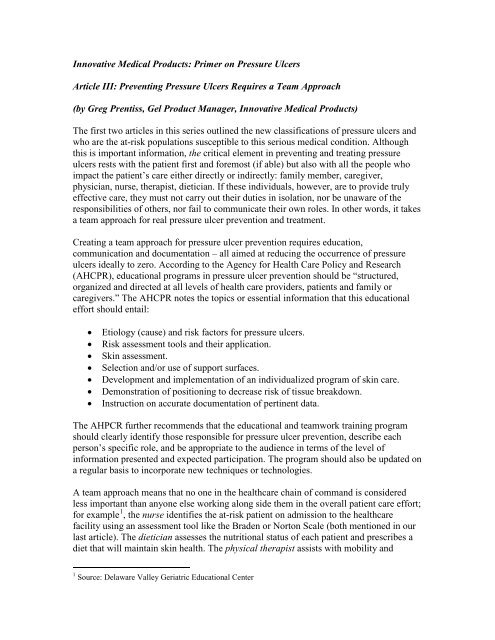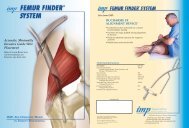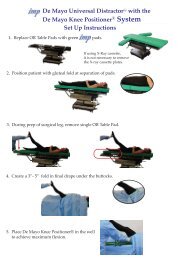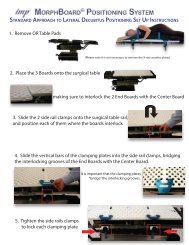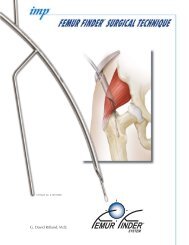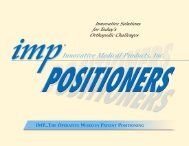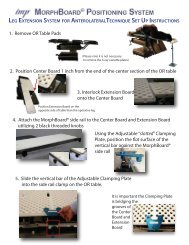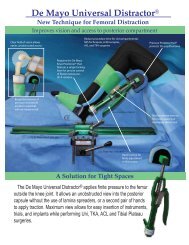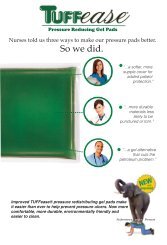Pressure Ulcer Article #3 - Innovative Medical Products
Pressure Ulcer Article #3 - Innovative Medical Products
Pressure Ulcer Article #3 - Innovative Medical Products
- No tags were found...
Create successful ePaper yourself
Turn your PDF publications into a flip-book with our unique Google optimized e-Paper software.
<strong>Innovative</strong> <strong>Medical</strong> <strong>Products</strong>: Primer on <strong>Pressure</strong> <strong>Ulcer</strong>s<strong>Article</strong> III: Preventing <strong>Pressure</strong> <strong>Ulcer</strong>s Requires a Team Approach(by Greg Prentiss, Gel Product Manager, <strong>Innovative</strong> <strong>Medical</strong> <strong>Products</strong>)The first two articles in this series outlined the new classifications of pressure ulcers andwho are the at-risk populations susceptible to this serious medical condition. Althoughthis is important information, the critical element in preventing and treating pressureulcers rests with the patient first and foremost (if able) but also with all the people whoimpact the patient’s care either directly or indirectly: family member, caregiver,physician, nurse, therapist, dietician. If these individuals, however, are to provide trulyeffective care, they must not carry out their duties in isolation, nor be unaware of theresponsibilities of others, nor fail to communicate their own roles. In other words, it takesa team approach for real pressure ulcer prevention and treatment.Creating a team approach for pressure ulcer prevention requires education,communication and documentation – all aimed at reducing the occurrence of pressureulcers ideally to zero. According to the Agency for Health Care Policy and Research(AHCPR), educational programs in pressure ulcer prevention should be “structured,organized and directed at all levels of health care providers, patients and family orcaregivers.” The AHCPR notes the topics or essential information that this educationaleffort should entail:• Etiology (cause) and risk factors for pressure ulcers.• Risk assessment tools and their application.• Skin assessment.• Selection and/or use of support surfaces.• Development and implementation of an individualized program of skin care.• Demonstration of positioning to decrease risk of tissue breakdown.• Instruction on accurate documentation of pertinent data.The AHPCR further recommends that the educational and teamwork training programshould clearly identify those responsible for pressure ulcer prevention, describe eachperson’s specific role, and be appropriate to the audience in terms of the level ofinformation presented and expected participation. The program should also be updated ona regular basis to incorporate new techniques or technologies.A team approach means that no one in the healthcare chain of command is consideredless important than anyone else working along side them in the overall patient care effort;for example 1 , the nurse identifies the at-risk patient on admission to the healthcarefacility using an assessment tool like the Braden or Norton Scale (both mentioned in ourlast article). The dietician assesses the nutritional status of each patient and prescribes adiet that will maintain skin health. The physical therapist assists with mobility and1 Source: Delaware Valley Geriatric Educational Center
positioning devices, encouraging the patient to stay active. The direct care staff providesthe first line of defense in protecting the patient from pressure ulcers: turning theimmobile patient regularly, assuring adequate food and fluid in-take, and inspecting theskin frequently to identify early signs of skin injury. “As part of the direct care staff,nursing aides, for example, can play a huge role as they see the patient’s skin mostfrequently during washing, toileting, dressing and other activities of daily living[ADLs],” notes Michelle Kunsman, faculty member in the University of Hartford’sdepartment of physical therapy. “If aides are educated in what to look for, and are madeto feel an important part of the team, they can be a tremendous help along with everyother team member. Overall, ‘the more eyes, the better’ when it comes to pressure ulcerprevention.”A multi-disciplinary team, of course, does not just happen on its own. It takes planningand organization (e.g., standardized and written protocols, assignment and documentationof responsibilities), communication (regular give-and-take, sharing of problems and bestpractices) and continuous improvement (quality control and built-in mechanisms toevaluate program effectiveness) to succeed.Sometimes healthcare facilities anoint “champions” who help drive the pressure ulcerprevention team effort, for example, “skin champions” or “unit champions.” Theseindividuals, because of their expertise, experience and dedication, are charged withresponsibility for ensuring zero-tolerance of pressure ulcers within their particular workgroup or caregiving area.Besides champions, physician and nurse overseers, direct care staff and family membersthemselves, the team approach also includes people even at a distance from the patientbut whose role is nevertheless critical and integral to team collaboration. Materialsmanagement and purchasing officials, as well as facility administrators, for example, allshare in the pressure ulcer prevention mission and are charged to give staff their fullsupport and the materials they need to do their jobs successfully.Above all, for the ideal team approach, creating a general culture of empowerment andreward throughout the healthcare facility will help ensure staff accountability andsuperior performance. When everyone on the team feels a real “ownership” of their rolein maintaining and improving patient protection, the better the chance that pressure ulcerscan be prevented or stopped from recurring in pursuit of the zero tolerance goal.ConclusionWe have seen in the first three articles of this series that the prevention, detection andtreatment of pressure ulcers depends on a knowledge of pressure ulcer causes andcategories, identification of at-risk populations, and the creation of a holistic or teamapproach in caring for the patient. Patient care, however, cannot be accomplished withoutthe aid of useful pressure ulcer prevention equipment. In our next and final article, wewill survey the kinds of product options that are available on the market today forpreventing pressure ulcers. Each solution category will be evaluated for its medicaleffectiveness, practicality of use, and cost efficiencies.


